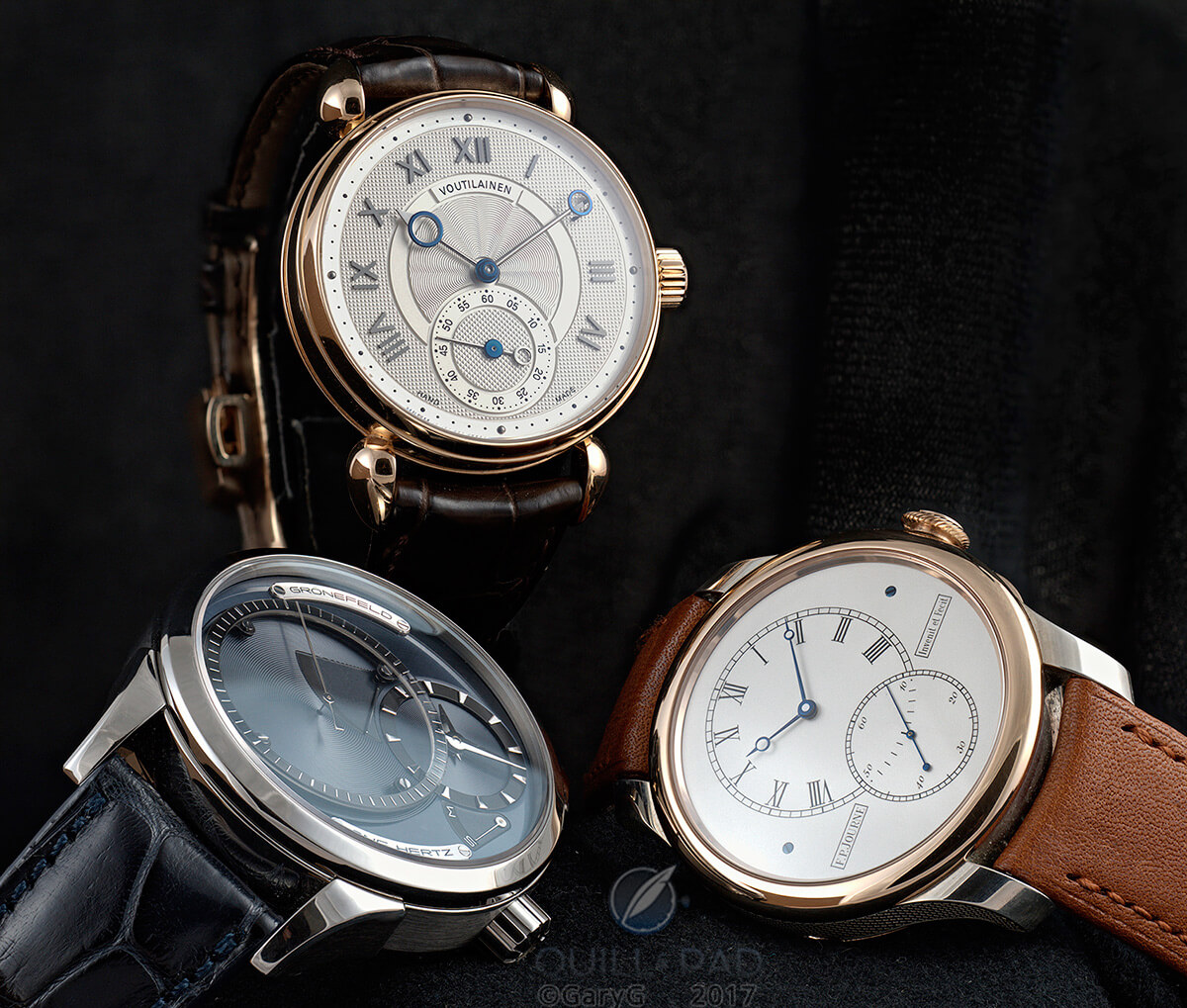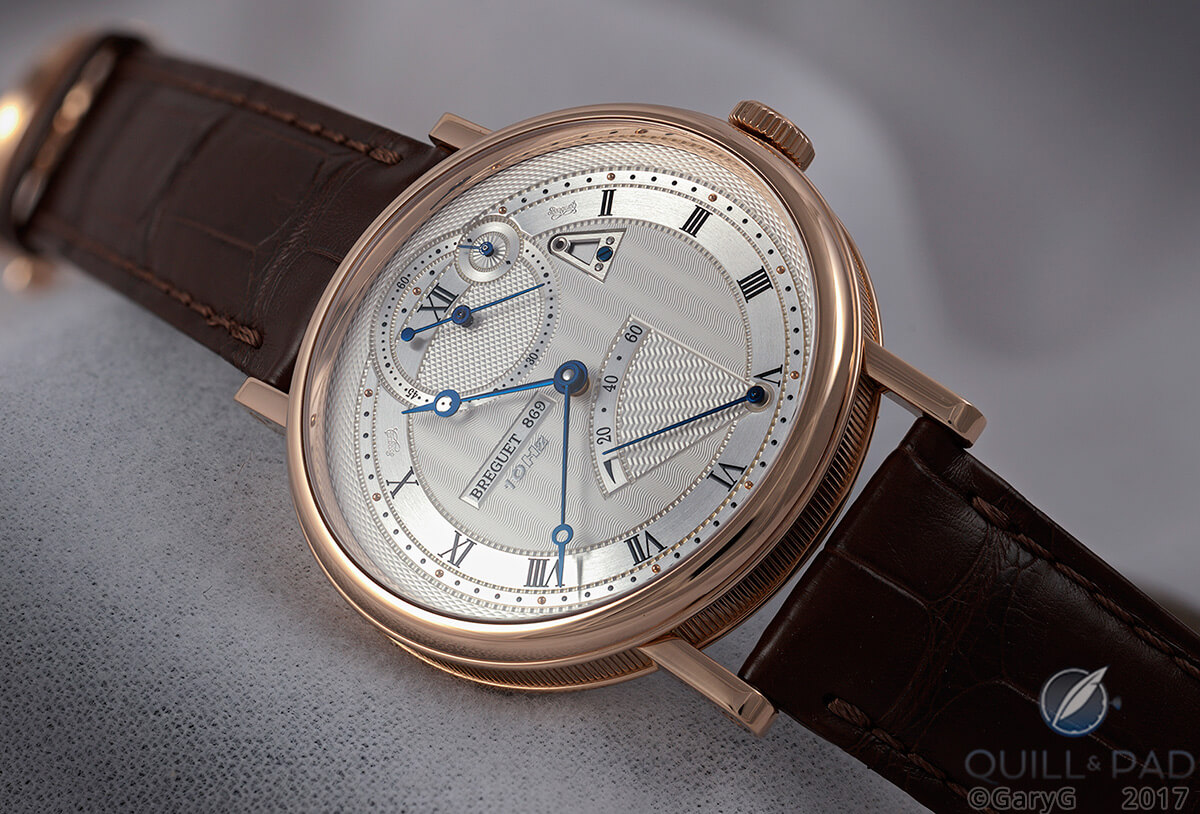by GaryG
Wouldn’t it be splendid to have everything your heart desired? Imagine, as a collector, having the resources to buy each and every watch you wanted without ever having to sell any of your existing collection.
Well, it’s a nice fantasy but it’s not going to happen for me, nor I expect for all but a very few of the collectors I know. And besides, I’m not so sure that the experience of “selling to buy” isn’t actually a significant part, albeit a bittersweet one, of the collecting experience.

Gone but not forgotten: Ulysse Nardin Monopusher Chronograph
Over the past 25 years, I’ve gone through four identifiable waves of selling to buy. As I developed my notes for this article, I actually surprised myself with the number of pieces I’ve sold over the years, including many I’d love still to own today.
I must confess that as I putting these words onto the page I also experienced a bit of trepidation: while it’s great to write about “Why I Bought It,” it’s perhaps a bit less flattering to those involved to confess, “Oh, by the way, I sold it.”
So, as we get underway, two modest requests:
- To those makers whose watches I’ve sold, don’t hate me! I’ve loved every one of these watches in its time and done my best to see that they found other loving homes.
- To other collectors and readers, please don’t judge me too harshly! You may shake your heads at some of my choices, but I hope that you find my thought process and lessons learned informative as you build your own collections.

Early collecting days: Parmigiani Kalpa Stainless Steel
Transition one: changing tastes
Early on, my watch buying preferences centered on Jaeger-LeCoultre (see Jaeger-LeCoultre: A Collector’s Gateway Drug And Ongoing Pleasure). In the early 2000s, I also struck up relationships with two local authorized dealers who introduced me to the worlds of Parmigiani and Ulysse Nardin, leading to a number of purchases.

Building a collection: Ulysse Nardin Marine Chronometer
Around 2005, something wonderful happened: largely through the kind offices of friend and indie advocate Tim Jackson, I became aware of the fantastic world of independent watchmaking. At the same time, through online forums like The PuristS my eyes were opened to pieces like the Audemars Piguet Equation of Time and Vacheron Constantin’s skeletonized watches.
Over the next few years, the face of my small collection changed quite a bit. Out went my Jaeger-LeCoultre Reverso Duoface and Art Deco, along with one-time must-haves like a blue-dialed Ulysse Nardin Marine Chronometer and a Panerai Ferrari Chronograph (in my defense, all that I can say about that watch is that I did own the matching car, more about that later).

Kept the car, sold the watch: Panerai Ferrari Chronograph
Through 2010, incoming pieces included two from Peter Speake-Marin (the Shimoda and his Fighting Time collaboration with Kees Engelbarts), an ultra-thin skeletonized Vacheron Constantin, the aforementioned Audemars Piguet Equation of Time, two Habring2 watches, and the capper, a pink gold Observatoire from Kari Voutilainen. I also took the opportunity to trade up within my Jaeger-LeCoultre assortment, buying a pre-owned Reverso Repetition Minutes.

Moving on up: Vacheron Constantin Malte Squelette
If you’re keeping track, you may already have noted a clear cheat: starting with each wave of selling and buying, the total value of my collection went up! For me (and I suspect for many others) selling is only a partial offset to buying; but at least it keeps us in the game.
Transition two: going bigger with the indies and A. Lange & Söhne
At SIHH 2011, more or less out of nowhere, I informed my watch buddies that I planned over the next year or two to sell a significant number of “smaller” pieces in favor of a set of more important watches.

Getting tougher: red gold Shimoda #1 by Peter Speake-Marin
As it turned out, I kept to my word: within 18 months, I had sold my first two Speake-Marin pieces, my remaining Ulysse Nardin watches including the lovely Monopusher pictured at the outset of this article that I still ache for from time to time, my pink gold JLC Memovox (still kicking myself about that one), my Parmigianis, and one of my Habring models.

Adding a keeper: Vianney Halter Antiqua
Through 2013, I restocked with some “bigger” watches within some of these brands (for instance, a Habring Doppel 2.0 and Speake-Marin Thalassa) and also added notable watches from the independents and A. Lange & Söhne, many of which form the core of my collection today: the Masterpiece Chronograph II from Kari Voutilainen, Vianney Halter’s Antiqua, a Grönefeld One Hertz, both a Datograph and a Double Split from A. Lange & Söhne, and a pre-owned Philippe Dufour Simplicity.

Foundation piece: Philippe Dufour Simplicity in white gold
During this period, while there was still a mix of new and pre-owned pieces in the additions to my collection, the center of gravity shifted a bit toward the pre-owned side, which enabled me to buy a larger number of fine watches than would have been the case had I insisted on all freshly-minted pieces.
Transition three: no pain, no gain
For me, the third phase of swapping began around 2014, by which time I was posting on a regular basis here on Quill & Pad, making my track record of purchases more visible through the “Why I Bought It” series.

One buys, another sells: F.P. Journe Tourbillon Souverain purchased by the author from a friend
Some truly wonderful watches joined the fold during in 2014 and 2015, including an early F.P. Journe Tourbillon Souverain and a Journe Anniversary Tourbillon “T30,” Romain Gauthier’s Logical One, an Upside Down from Ludovic Ballouard, Vianney Halter’s Deep Space Tourbillon, a Breguet Reference 7727 10 Hz chronometer, and a white gold A. Lange & Söhne Datograph Perpetual that I’d spent four years convincing a pal to sell to me.

Products of consolidation: the author’s two A. Lange & Söhne chronographs
Unexpectedly, I also stumbled across the opportunity to acquire what for me had been a real object of desire: Invention Piece 1 from Greubel Forsey (see Why I Bought It: Greubel Forsey Invention Piece 1).

Object of desire: Greubel Forsey Invention Piece 1, No. 01/11 in red gold
History will tell whether the timing of my purchase of the Greubel Forsey was optimal, but I simply had to have it, and as a result difficult choices had to be made. Deeply lamented departures included my Datograph, the Journe T30, Grönefeld One Hertz, Speake-Marin Thalassa, and Voutilainen Observatoire (the sale of which was characterized as no less than “a tragedy” by our editor-in-chief).

Worth it? Pieces sold to afford a Greubel Forsey
As much as I hated to sell those pieces, the process did help me to understand some of my decision rules as a collector, which included the following.

Making another collector happy: the author’s former A. Lange & Söhne Datograph
- I was willing to sell the Datograph as I kept the Double Split and Datograph Perpetual, which for me represented more advanced examples of A. Lange & Söhne’s chronograph expertise.
- With the addition of the Deep Space and Greubel Forsey, I was suddenly tourbillon-heavy; and as much as I would still love to be wearing the T30, I felt that the Tourbillon Souverain was a more essential representation of the Journe legacy.
- As the owner of another superb Voutilainen piece, I was willing to let the Observatoire go; had I not bought the Chronograph, I don’t think I’d have sold the Observatoire.

Love is fickle: Speake-Marin Thalassa in white gold
- Love is sometimes fickle: I found that I wasn’t pulling the Thalassa or One Hertz out of the box to wear on a regular basis.
Transition four: re-balancing and new frontiers
Over the past year or so, the shift has continued as I decided to nudge the balance of my collection more toward major brands (without abandoning the independents, as a couple of pending “incoming” pieces will demonstrate) and also began to pick up the vintage and classic watch bug (see A Contemporary Watch Collector Goes Vintage).

The “big three” recent additions to the author’s collection
On one monumental weekend last November, I added three landmark pieces: the Patek Philippe Reference 5370P split-seconds chronograph (see Why I Bought It: Patek Philippe Reference 5370P), the A. Lange & Söhne Pour le Merite Tourbillon (see Why I Bought It: A. Lange & Söhne Pour le Mérite Tourbillon), and a remarkable vintage Patek Philippe Reference 1526 perpetual calendar in pink gold.
That’s a pretty heavy load! To enable these acquisitions, some sales were needed:

Breguet Reference 7727 in pink gold
- The Breguet was the first to go: a lovely piece, but see “love is sometimes fickle” above.

Don’t be mad, Vianney: Deep Space Tourbillon by Vianney Halter
- Next out was the Vianney Halter Deep Space, dropping my tourbillon count again and at the same time keeping me in the game as a Halter owner with what I consider to be Halter’s most important piece, the Antiqua.

Yes, I sold my car for watches: the author in his former Ferrari 599 GTB Fiorano at Laguna Seca (photo courtesy Got Blue Milk)
- My car. In Economics 101 I think we called this category cross-elasticity, but I did actually sell my Ferrari 599 GTB Fiorano as part of financing these watches.
- If “not buying” can be considered selling, I did also cancel an order that I had placed for a wonderful perpetual calendar watch that I really wish I had kept – but then again, you can’t have everything!
Lessons learned: selling to buy
While I’m sure that there’s a certain amount of rationalization in these musings about selling to buy, perhaps there are a few useful lessons as well.
- For most of us, at some point we will need either to conclude that we are entirely happy with our collections or that we need to sell to buy.
- When you’re looking at a major potential acquisition, think about which watch in your current collection you’d consider selling to have the new one. If you can’t think of one, do you really need the new piece?

Re-purchase candidate? F.P. Journe Anniversary Tourbillon “T30”
- If you’re tempted to buy back an example of a watch that you’ve sold (and I am, especially with the Jaeger Memovox, Voutilainen Observatoire, and Journe T30), ponder exactly why you felt you could give it up in the first place.
- Try to be clear about your own rationale for choosing pieces to sell. For me, these include a desire to own pieces from multiple top makers and a variety of complication types, a preference to own one great piece over two smaller ones, and an explicit view of my desired portfolio mix (fun vs. investment vs. patronage).
- If you’re not wearing it, it might be time to sell it.
- Cheat on the rules if you must, but try to be honest with yourself. For instance, right now I’ve been telling myself, “It’s really not a good time in the cycle to sell, but it’s a good time to buy.” Well, okay, but when “now is not a good time” turns into “I never got around to selling,” that can be a real problem.
- If you find over time that your collection seems to be made up mostly of “keepers” and it’s very hard to part with any of them, take some comfort in the fact that you’re not alone.

Likely long-term keeper: first generation A. Lange & Söhne Datograph Perpetual in white gold
But most of all: enjoy! Happy hunting and feel free to share your own experiences with “selling to buy” in the comment section below.
* This article was first published on September 15, 2017 at Selling Watches To Buy Watches: One Collector’s Story.
You may also enjoy:
False Scarcity And Steel Sports Watches: A Collector’s View
Hammer Time: Expert Advice For Selling Your Watch At Auction
Leave a Reply
Want to join the discussion?Feel free to contribute!





















































I’d love to hear about how you sell your watches. In 2020 there are so many ways to sell watches (eBay, auction house, dealer, consignment) I’m wondering which you chose and how you chose it. It could be a great subject for an article since I’m sure many other of your readers are in the same boat.
Thanks — I’ve added that topic to my list of upcoming article ideas!
Best, Gary
Gary, I share your pain. At a period of significant financial stress, I sold my Voutilainen Observatoire to a collector friend. It retains pride of place in his collection, and I’m glad it found a good home.
The good news is that part of that sale was used to leverage the purchase of one of the original set of twelve Grönefeld One Hertz in stainless steel. Whilst I just about burst into tears every time I think about the loss of that Kari, the One Hertz makes up for it. The Observatoire was the watch that really launched Kari’s career (although of course not the first watch he made under his own name); similarly, the One Hertz was the watch that put the Horological Brothers on the map. And to my knowledge, it’s the only watch they have ever cased up in steel. To me, this history is important!
As an aside, I notice that the One Hertz you sold appears to be from that same batch of twelve. Now really Gary – you definitely shouldn’t have sold that one. (OTOH I am aware that you have an Eight Second Remontoire these days, so I guess Bart and Tim have forgiven you…)
Cheers
Tony P
Great to hear from you, Tony! Sounds as if you are still as addicted to the watch hobby as ever, which is great to hear.
If there’s an “even worse” on that One Hertz of mine, it was a special in Titanium with the blue dial from the PT version of the watch. As you say, happily the Dutch are forgiving!
Best, Gary
Gary, I respected you so much for story about your “beater” DeBethune. Now all that respect is gone. How could you let the Deep Space go over a patrician Patek. All I can say is Arggggggh! Kidding, whatever floats your boat, is great. That is why there are different makers. Keep your articles coming. You live in what to me is a rarified atmosphere financially but I still appreciate you sharing your “finds” with the rest of us, Thank you.
Hi Shirl — you have me laughing (if somewhat sheepishly) on this end! Your comment reminds me that I could also write a tutorial about how to buy and sell particular watches at exactly the wrong times 🙂
At least I still have the Antiqua! From a “collection” perspective, that’s the more characteristic VH watch to have and I don’t see myself parting with it any time soon.
Thanks for sharing your thoughts!
All the best, Gary